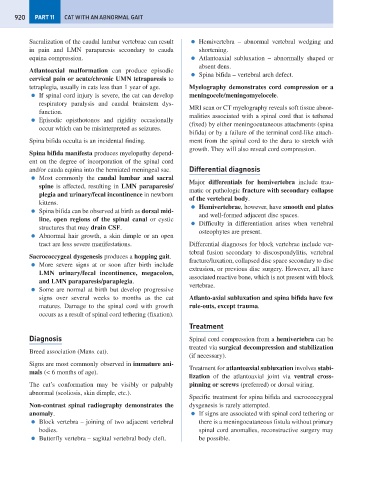Page 928 - Problem-Based Feline Medicine
P. 928
920 PART 11 CAT WITH AN ABNORMAL GAIT
Sacralization of the caudal lumbar vertebrae can result ● Hemivertebra – abnormal vertebral wedging and
in pain and LMN paraparesis secondary to cauda shortening.
equina compression. ● Atlantoaxial subluxation – abnormally shaped or
absent dens.
Atlantoaxial malformation can produce episodic
● Spina bifida – vertebral arch defect.
cervical pain or acute/chronic UMN tetraparesis to
tetraplegia, usually in cats less than 1 year of age. Myelography demonstrates cord compression or a
● If spinal cord injury is severe, the cat can develop meningocele/meningomyelocele.
respiratory paralysis and caudal brainstem dys-
MRI scan or CT myelography reveals soft tissue abnor-
function.
malities associated with a spinal cord that is tethered
● Episodic opisthotonos and rigidity occasionally
(fixed) by either meningocutaneous attachments (spina
occur which can be misinterpreted as seizures.
bifida) or by a failure of the terminal cord-like attach-
Spina bifida occulta is an incidental finding. ment from the spinal cord to the dura to stretch with
growth. They will also reveal cord compression.
Spina bifida manifesta produces myelopathy depend-
ent on the degree of incorporation of the spinal cord
and/or cauda equina into the herniated meningeal sac. Differential diagnosis
● Most commonly the caudal lumbar and sacral
Major differentials for hemivertebra include trau-
spine is affected, resulting in LMN paraparesis/
matic or pathologic fracture with secondary collapse
plegia and urinary/fecal incontinence in newborn
of the vertebral body.
kittens.
● Hemivertebrae, however, have smooth end plates
● Spina bifida can be observed at birth as dorsal mid-
and well-formed adjacent disc spaces.
line, open regions of the spinal canal or cystic
● Difficulty in differentiation arises when vertebral
structures that may drain CSF.
osteophytes are present.
● Abnormal hair growth, a skin dimple or an open
tract are less severe manifestations. Differential diagnoses for block vertebrae include ver-
tebral fusion secondary to discospondylitis, vertebral
Sacrococcygeal dysgenesis produces a hopping gait.
fracture/luxation, collapsed disc space secondary to disc
● More severe signs at or soon after birth include
extrusion, or previous disc surgery. However, all have
LMN urinary/fecal incontinence, megacolon,
associated reactive bone, which is not present with block
and LMN paraparesis/paraplegia.
vertebrae.
● Some are normal at birth but develop progressive
signs over several weeks to months as the cat Atlanto-axial subluxation and spina bifida have few
matures. Damage to the spinal cord with growth rule-outs, except trauma.
occurs as a result of spinal cord tethering (fixation).
Treatment
Diagnosis Spinal cord compression from a hemivertebra can be
treated via surgical decompression and stabilization
Breed association (Manx cat).
(if necessary).
Signs are most commonly observed in immature ani-
Treatment for atlantoaxial subluxation involves stabi-
mals (< 6 months of age).
lization of the atlantoaxial joint via ventral cross-
The cat’s conformation may be visibly or palpably pinning or screws (preferred) or dorsal wiring.
abnormal (scoliosis, skin dimple, etc.).
Specific treatment for spina bifida and sacrococcygeal
Non-contrast spinal radiography demonstrates the dysgenesis is rarely attempted.
anomaly. ● If signs are associated with spinal cord tethering or
● Block vertebra – joining of two adjacent vertebral there is a meningocutaneous fistula without primary
bodies. spinal cord anomalies, reconstructive surgery may
● Butterfly vertebra – sagittal vertebral body cleft. be possible.

